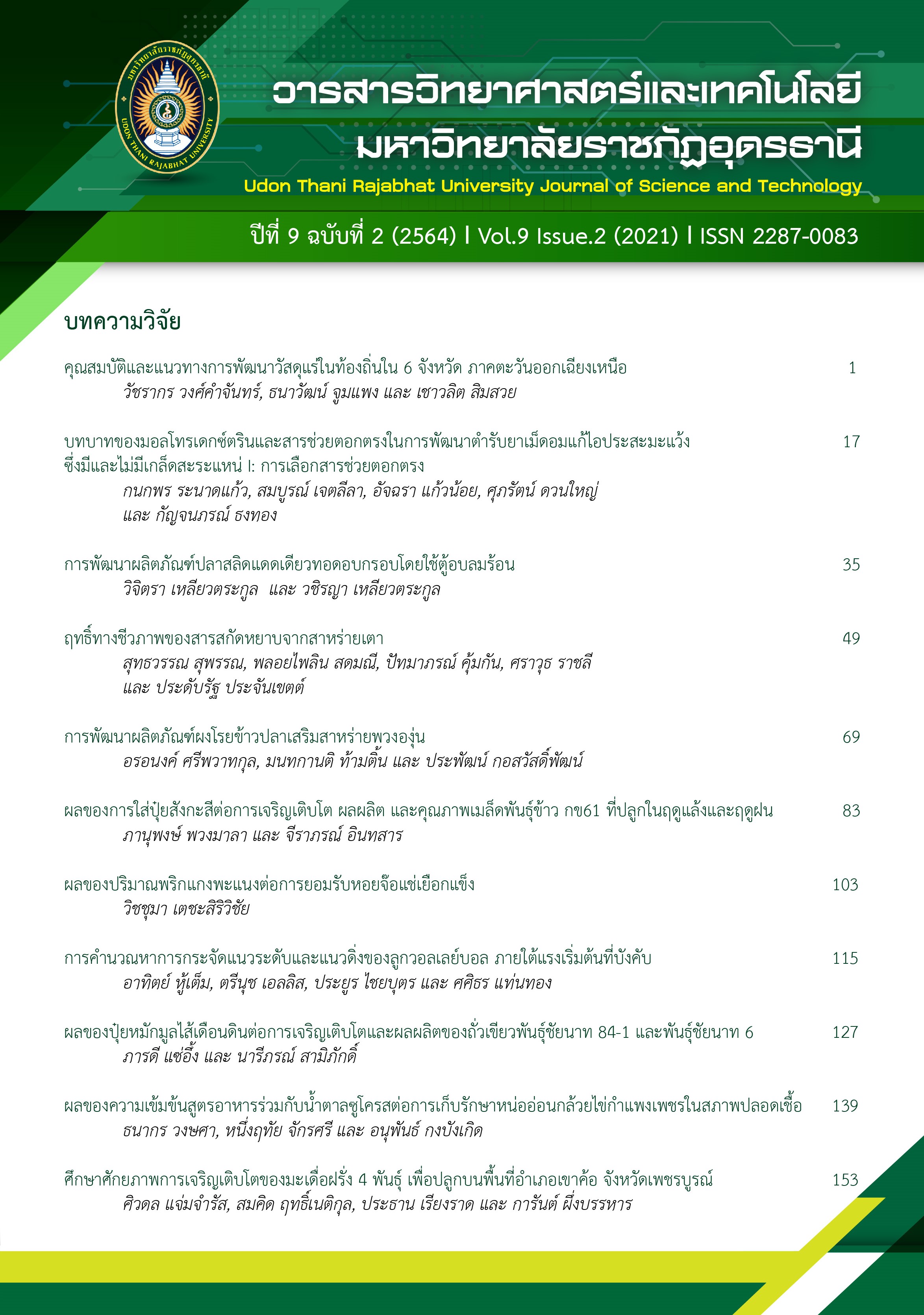THE PRODUCT DEVELOPMENT OF FISH RICE-SEASONING FISH SUPPLEMENTED WITH GREEN CAVIAR
Main Article Content
Abstract
The objective of this research was to study the drying process of green caviars that were discarded during trimming and to study the appropriate amount of green caviars that could be supplemented into the fish rice-seasoning. The drying process was experimented by using sun drying and hot-air oven drying at temperatures of 50, 60 and 70 ˚C. It was found that the moisture content (12.03-12.31%), salinity (62-63 ppt) and aw (0.50-0.53) of dried green caviars were not significantly different (p>0.05). The sun-dried green caviars were generally pale green and some were white. On the other hand, the hot-air oven dried green caviars did not show any significant difference in appearance between the three drying temperatures. The dark green colour of hot-air dried green caviars along with their odour and salty taste were retained. Therefore, drying process at 70 ˚C was selected due to its shortest drying time. The results of supplementing 2%, 3% and 4% of green caviars into the basis formula of fish rice-seasoning revealed that the amount of green caviars influenced sensory evaluation of the fish rice-seasoning product in terms of flavour and overall preference at p>0.05. The supplementing of 3% green caviars into the product showed highest acceptance by consumers. The developed formula of fish rice-seasoning consisted of 34 g of shredded seasoned milkfish, 14 g of fried red onion, 14 g of fried garlic, 14 g of white sesame, 7 g of black sesame, 7 g of seasoning sauce, 6 g of light soy sauce, 3 g of sugar, 1 g of seasoning powder and 3 g of dried green caviars. The developed rice-seasoning was rated at 8.09 in overall satisfaction which indicated ‘most’ and ‘more’. The product’s L* a* b* value was at 45.49 5.26 and 23.09 respectively and its measured aw was at 0.34. The green caviars would add the seaweed taste and flavour in fish rice-seasoning but the excessive addition of green caviars would result in too salty product.
Article Details
References
เกริกชัย ชีระปฏิยุทธ. (2552). ผลิตภัณฑ์ผงผักปรุงรสโรยข้าวแคลเซียมสูงจากไข่น้ำ (วอลฟ์เฟียกลอโบซ่า). (วิทยานิพนธ์วิทยาศาสตร์มหาบัณฑิต, จุฬาลงกรณ์มหาวิทยาลัย).
นพรัตน์ มะเห, มาโนช ขำเจริญ และ ดลฤดี พิชัยรัตน์. (2562). คุณค่าทางโภชนาการและการเปลี่ยนแปลงคุณภาพของสาหร่ายพวงองุ่น (caulerpa lentillifera) หลังการเก็บเกี่ยว. วารสารวิทยาศาสตร์ มข., 47(3), 478-489.
น้ำฝน ไชยลังการ. (2557). ผลกระทบของสภาวะและวิธีการอบแห้งต่อการเปลี่ยนแปลงคุณภาพสาหร่ายเตา. (วิทยานิพนธ์วิศวกรรมศาสตร์มหาบัณฑิต, มหาวิทยาลัยแม่โจ้).
ปราณี มีศิริสุข. (2553). เคมีอาหาร. ชลบุรี: มหาวิทยาลัยเทคโนโลยีราชมงคลตะวันออก.
พิชญอร ไหมสุทธิสกุล และ วิชมณี ยืนยงพุทธกาล. (2563). ผลของวิธีการลดความเค็มต่อสมบัติทางเคมีของสาหร่ายพวงองุ่น. วารสารวิจัย มหาวิทยาลัยเทคโนโลยีราชมงคลตะวันออก, 13(1), 92-101.
วลัย คลี่ฉายา และ สมยศ ราชนิยม. (2558). วิธีการจัดการและยืดอายุการเก็บรักษาคุณภาพสาหร่ายผักกาดทะเลและสาหร่ายไส้ไก่. รายงานผลการวิจัย, กองวิจัยและพัฒนาอุตสาหกรรมสัตว์น้ำ กรมประมง.
วิไล รังสางทอง. (2547). เทคโนโลยีการแปรรูปอาหาร. พิมพ์ครั้งที่ 4. กรุงเทพมหานคร: สถาบันเทคโนโลยีพระจอมเกล้าพระนครเหนือ.
สำนักงานมาตรฐานผลิตภัณฑ์อุตสาหกรรม.(2547). มาตรฐานผลิตภัณฑ์ชุมชน สาหร่ายทะเลอบแห้ง(มผช515/2547). สืบค้นเมื่อวันที่ 8 มิถุนายน 2564, จาก hhtp://tcps.tisi.go.th/pub/tcps515_47.pdf.
สำนักงานมาตรฐานผลิตภัณฑ์อุตสาหกรรม. (2562). มาตรฐานผลิตภัณฑ์ชุมชน ผงโรยข้าวจากสาหร่าย(มผช1512/2562). สืบค้นเมื่อวันที่ 5 มกราคม 2563, จาก http://tcps.tisi.go.th/public/StandardList.aspx.
สำนักงานเศรษฐกิจการเกษตร. (2563). ปริมาณและมูลค่าการนำเข้าสินค้าเกษตรและอาหาร. สืบค้นเมื่อวันที่ 8 มิถุนายน 2564, จาก http://impexp.oae.go.th/service/report_product01.php?S_YEAR=2563&i_type=1&PRODUCT_ID=1273&wf_search=&WF_SEARCH=Y#4476.
สิริมา ชินสาร และ นิสานารถ กระแสร์ชล. (2562). การพัฒนากรรมวิธีการผลิตสาหร่ายพวงองุ่น อบแห้งคืนรูปเร็ว. รายงานผลการวิจัย, มหาวิทยาลัยบูรพา.
สุพล ตั่นสุวรรณ, มนทกานติ ท้ามติ้น และ สันติภาพ แซ่เฮ้า. (2555). สาหร่ายพวงองุ่น“Green Caviar”. สืบค้นเมื่อวันที่ 5 มกราคม 2563, จาก https://www.fisheries.go.th.
Matanjun, P., Mohamed, S., Mustapha, N. M., & Muhammad, K. (2009). Nutrient content of tropical edible seaweeds, Eucheuma cottonii, Caulerpa lentillifera and Sargassum polycystum. Journal of Applied Phycology, 21, 75–78.
Nagappan, T., & Vairappan, C. S. (2014). Nutritional and bioactive properties of three edible species of green algae, genus caulerpa (caulerpacrae). Journal of Applied Phycology, 26(2), 1019-1027.
Ratana-Arporn, P., & Chirapart, A. (2006). Nutritional evaluation of tropical green seaweeds Caulerpa lentillifera and Ulva reticulate. Kasetsart Journal (Natural Science), 40 (Suppl), 75–83.
Therdthai, N., & Zhou, W. (2009). Characterization of microwave vacuum drying and hot air drying of mint leaves (Mentha cordifolia Opiz ex Fresen). Journal of Food Engineering, 91(3), 482–489.


